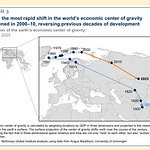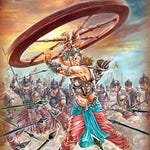A version of this essay was published by firstpost.com on April 8th at https://www.firstpost.com/opinion/shadow-warrior-generative-ai-creates-challenges-in-intellectual-property-and-epistemology-13757273.html
It is fairly obvious that the dominant, i.e. Western mechanism for generating new knowledge is rather different from the traditional Indian mechanism, and this shows up in all sorts of ways. One is that Indian epistemology seems to be empirical and practical, based on observation; whereas the Western tradition seems to prefer grand theories that must then be proved by observation.
Another difference is the Western idea that Intellectual Property is a private right that the State confers on an inventor or a creator. The Western gaze is fixed on the potential monetary gains from a monopoly over the use of the IP Right (for a fixed period of time, after which it is in the public domain): the argument is that it eventually helps everybody, while incentivizing the clever.
The Indian concept is vastly different. It was assumed that a creator created, or an inventor invented, as a result of their innate nature, their god-given gifts. In a way they could not avoid being creative or inventive, which would be a negation of the blessing they had received from the Supreme Brahman. Therefore no further incentive was needed: benevolent patrons like kings or temples would take care of their basic needs, allowing them to give free rein to creativity and innovation.
This seems to us today to be a radical idea, because we have been conditioned by the contemporary epistemological idea that incentives are a necessary condition for knowledge creation. Although this seems common-sensical, there is no real evidence that this is true. Petra Moser, then at MIT, discovered via comparing 19th century European countries that the presence of an IPR culture with incentives made little difference in the quantum of innovation, although it seemed to change the domains that were the most innovative..
In fact, there is at least one counter-example: that of Open Source in computing. It boggles the imagination that veritable armies of software developers would work for free, nights and weekends, in addition to their full-time jobs, and develop computing systems like Linux that are better than the corporate versions out there: the whole “Cathedral and Bazaar” story as articulated by Eric Raymond. Briefly, he argues that the chaotic ‘bazaar’ of open source is inherently superior to the regimented but soul-less ‘cathedral’ of the big tech firms.
It is entirely possible that the old Indian epistemological model is efficient, but the prevailing model of WIPO, national Patent Offices, and all that paraphernalia massively benefits the Western model. As an example, the open-source model was predicted to make a big difference in biology, but that effort seems to have petered out after a promising start. Therefore we are stuck for the foreseeable future with the IP model, which means Indians need to excel at it.
In passing, let us note that the brilliant Jagdish Chandra Bose was a pioneer in the wireless transmission of information, including the fundamental inventions that make cellular telephony possible. However, as a matter of principle, he refused to patent his inventions; Guglielmo Marconi did, and became rich and famous.
India has traditionally been quite poor in the number of patents, trademarks, copyrights, geographical indications, semiconductor design layouts etc. that it produces annually. Meanwhile the number of Chinese patents has skyrocketed. Over the last few years, the number of Indian patents has grown as the result of focused efforts by the authorities, as well as the realization by inventors that IP rights can help startup firms dominate niche markets.
India also produces a lot of creative works, including books, films, music and so on. The enforcement of copyright laws has been relatively poor, and writers and artistes often do not get fair compensation for their work. This is deplorable.
Unfortunately, things will get a lot worse with generative AI. Most of us have heard of, and probably also tried out, the chatbots that have been the object of much attention and hype in the past year, such as chatGPT from OpenAI/Microsoft and Bard from Google. Whether these are truly useful is a good question, because they seduce us into thinking they are conscious, despite the fact that they are merely ‘stochastic parrots’. But I digress.
The point is that the digital revolution has thrown the edifice of copyright law into disarray. At the forefront of this upheaval stands generative AI, a technology with the uncanny ability to mimic and extend human creative output. Consider two stark examples: the contentious case of J.K. Rowling and her copyright battle with a Harry Potter-inspired fanfic, and the recent Japanese law that grants broad exemptions for training large language models (LLMs).
J.K. Rowling's spat with Anna M. Bricken, the author of a Harry Potter fanfic titled "Harry Potter and the Goblet of Wine," ignited a global debate about fair use and transformative creativity. Bricken's work reimagined the Potterverse with an adult lens, but Rowling, citing trademark infringement, sought to have it taken down.
While the case eventually settled, it exposed a fundamental dilemma: can AI-generated works, even if derivative, be considered distinct enough from their source material to warrant copyright protection? The answer, shrouded in legal ambiguity, leaves creators navigating a tightrope walk between inspiration and infringement.
On the other side of the globe, Japan enacted a law in 2022 that further muddies the waters. This controversial regulation grants LLMs and other AI systems an almost carte blanche to ingest and remix copyrighted material for training purposes without seeking permission or paying royalties. While proponents laud it as a catalyst for AI innovation, critics warn of widespread copyright infringement and a potential future where authorship becomes a nebulous concept. The Japanese law, echoing anxieties around J.K. Rowling's case, raises unsettling questions: who owns the creative spark when AI fuels the fire?
For India, a nation at the precipice of the AI revolution, these developments raise crucial questions. With a burgeoning AI industry and a large creative sector, India must tread carefully. Adapting existing copyright laws to encompass the nuances of AI-generated works is paramount. Robust fair use guidelines that incentivize transformative creativity while safeguarding original authorship are urgently needed. Furthermore, fostering ethical AI development practices that respect intellectual property rights is crucial.
The debate surrounding AI and copyright is not merely a legal tussle; it's a battle for the very definition of creativity. In this fight, India has the opportunity to carve a path that balances innovation with artistic integrity. By acknowledging the complexities of AI while upholding the cornerstone principles of copyright, India can become a global leader in navigating the uncharted territory of digital authorship. The future of creativity, fueled by both human imagination and AI's boundless potential, hangs in the balance, and India has the chance to shape its trajectory.
Disclaimer: The last few paragraphs above were written by Google Bard, and lightly edited. A chatbot can produce coherent text, but it may be, and often is, completely wrong (‘hallucinations’). Now who owns the copyright to this text? Traditionally, it would be owned by me and Firstpost, but what is the right answer now? Would we be responsible for any errors introduced by the AI?
On the other hand, the ‘mining’ of text, audio/video and images to train generative AI is an increasingly contentious issue. As an example, the New York Times sued OpenAI and Microsoft, arguing that they weren’t being paid anywhere near the fair market value of their text that the tech companies mined.
This sounds familiar to Indians, because Westerners have been ‘digesting’ Indian ideas for a long time. Some of the most egregious examples were patents on basmati, turmeric and neem, which are absurd considering that these have been in use in India for millennia. The fact that these were documented in texts (‘prior art’) enabled successful challenges against them.
An even more alarming fact is the capture and ‘digestion’ (a highly evocative term from Rajiv Malhotra, who has warned of the dangers of AI for years) of Indian personal and medical data. Unlike China, which carefully firewalls away its data from Western Big Tech, and indeed, does not even allow them to function in their country, Indian personal data is being freely mined by US Big Tech. India’s Data Privacy laws, being debated now, need to be considered defensive weapons.
Paradoxically, there is also the concern that Indic knowledge will, for all intents and purposes, disappear from the domain of discourse. Since the chatbots are trained on the uncurated Internet, they are infected by the Anglosphere prejudices and bigotry therein, not to mention deliberate misinformation and ‘toolkits’ that are propagated.
Since most Indic concepts are either not very visible, or denigrated, on the Internet (eg Wikipedia), chatbots are not even aware of them. For instance, a doctor friend and I published an essay in Open magazine comparing allopathy to generative AI, because both are stochastic (ie. based on statistics). We mentioned Ayurveda positively several times, because it has a theory of disease that makes it more likely to work with causation rather than correlation.
However, when the article summarized by chatGPT, there was no mention whatsoever of the word ‘Ayurveda’. It is as though such a concept does not exist, which may in fact be true in the sense that it is deprecated in the training data that the chatbot was trained on.
One solution is to create Indian foundational models that can then become competent in specific domains of interest: for example an Arthashastra chatbot. These can also be trained, if sufficient data sets are created, on Indian languages as well, which could incidentally support real-time machine translation as well. Thus there can be an offensive as well as a defensive strategy to enable Indic knowledge systems to thrive.
India is at a point of crisis, but also of opportunity. If India were to harness some of the leading-edge technologies of today, it might once again become a global leader in knowledge generation, as it was a millennium ago with its great universities.
1680 words, Jan 10, 2024 updated Apr 7, 2024













